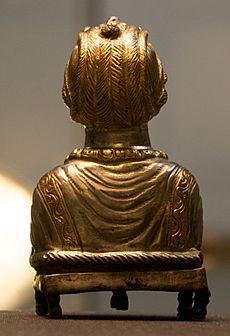Empress pepper pot facts for kids
Quick facts for kids Empress pepper pot |
|
|---|---|

The "Empress" Pepper Pot from the Hoxne Hoard on display in the British Museum
|
|
| Material | Silver (gilt) |
| Size | Height:103 mm (4.1 in) Diameter:33 mm (1.3 in) Weight:107.9 g |
| Created | 4th Century A.D. |
| Period/culture | Roman |
| Place | Hoxne, Suffolk |
| Present location | Room 49, British Museum, London |
| Registration | 1994,4-8 33 |
The Hoxne hoard pepper pot, often called the Empress pepper pot, is a special silver container. It is partly covered in gold and was made around 400 AD during the Roman period.
This unique pot was discovered in November 1992. It was part of a huge collection of Roman treasures found in Hoxne, Suffolk, England. Today, you can see it at the British Museum in London.
The pepper pot is shaped like the top half of a woman's body. It is hollow inside. You could load ground pepper or other expensive spices into its base. Then, you would shake it to sprinkle the spices out.
The pot has a clever lid that can turn. It has three positions: one for filling the pot, one with tiny holes to let the pepper out, and one to close it completely. This amazing item was even featured in a BBC Radio 4 series called A History of the World in 100 Objects as item number 40.
Ancient Roman Pepper Pots
Pepper pots like the Empress are quite rare finds from Roman times. Four of these special pots, including the Empress, were found together in the Hoxne Hoard. People believe these pots held pepper or other costly spices.
We know Romans used pepper because tiny pieces of black pepper have been found at old Roman sites. Also, ancient Roman writings, like the Vindolanda tablets, mention buying pepper. It was quite expensive!
Romans also used many other flavorings in their food. These included coriander, poppyseed, celery, dill, summer savoury, mustard, and fennel. We know about these from old Roman recipes that have been translated.
Some other "pepper casters" were found in Pompeii, but they might have been used for tasting wine, not for pepper. The only items that are definitely Roman pepper pots were made after 250 AD. They have been found in places like France, Bulgaria, and possibly Sidon.
Why is it called the Empress?
The Hoxne pepper pot looks a lot like some weights used in the later Eastern Roman Empire. When the Hoxne Hoard was first found, people thought these weights showed an empress. So, the pepper pot was also given the name "Empress."
However, experts now think these figures are not meant to be an empress or even a Roman goddess. The figures often hold a scroll, which shows they were educated and wealthy. But they don't wear a diadem, which is a special crown worn by an empress.
Further study of the pepper pot itself suggests that "lady" would be a more fitting name. But because the pepper pot became famous so quickly, the name "Empress" stuck. People still use it, even though it might not be perfectly accurate.
See also
 In Spanish: Pimentero de la emperatriz para niños
In Spanish: Pimentero de la emperatriz para niños


